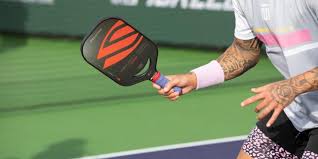What pickleball paddle handle length is best?
We're talking about pickleball here, and size matters!
As the sport continues to grow, strategies change and so does paddle technology. Lately, we are seeing the trends of longer handles coming out from various companies but what does that mean? Are there advantages and how about grip size? What do thick vs. thin handles offer and take away?
There is no doubt that the sport is beginning to show how paddles can affect the game. There is more spin than ever, the ball is being hit bigger, and let's face it - people are getting damn good at Pickleball. Many can overlook handle length and how it can affect their game and I'm here to give some insight into what I've seen working for people.
Long-handled paddles often allow you to more comfortably use two-handed shots, which we see a lot of tennis converts swinging on their backhands. In addition, the longer paddles often provide a little longer reach and provide more surface area for people with bigger hands. However, longer handles usually are accompanied by a smaller paddle face which in turn are geared for more intermediate-advanced players.
This is not to say advanced players shouldn't use short-handled paddles. I often see racketball and ping-pong players using short-handled paddles because often table tennis players have their index finger extended and placed on the face of the paddle for stability. Racketball players are just used to smaller handles in general. Shorter handle paddles also often come with a larger surface which provides a bigger sweetspot and ultimately more comfort. Therefore, if you find yourself choking up higher on the paddle with a long handle you might be sacrificing some reach. So the short-handled paddle may actually give you more reach since the face of them is usually larger.
Thick and thin Grips also affect playability. I would recommend a thicker grip for players looking to have more stability on dink shots and touch. Also, people who might be suffering from tennis-elbow may want to look into building up the grip or having it thicker. The reason it may help with tennis-elbow is because if the grip is bigger, you wouldn't have to grip so tight to stabilize the paddle on off-center shots. Often I see people with big hands using a grip way too small and over-tensing the muscles in their forearm to maintain stability which causes tennis-elbow.
Thin grips on the other hand can provide more potential for maneuverability and paddle-head speed for serves, drives and passes. This can give players more spin potential and is something I see with players who know how to hold a racket loosely and often racketball converts.
It all comes down to personal preference and nothing is better than trial and error. Many more intricacies come with grip size and length, but these are the basics to start to figure out what works best for you.



